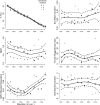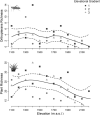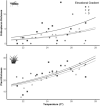Disentangling the role of environment in cross-taxon congruence of species richness along elevational gradients
- PMID: 33633146
- PMCID: PMC7907370
- DOI: 10.1038/s41598-021-83763-3
Disentangling the role of environment in cross-taxon congruence of species richness along elevational gradients
Abstract
Spatial patterns of species richness have been found to be positively associated, a phenom called cross-taxon congruence. This may be explained by a common response to environment or by ecological interactions between taxa. Spatial changes in species richness are related to energy and environmental heterogeneity but their roles in cross-taxon congruence remain poorly explored. Elevational gradients provide a great opportunity to shed light on the underlying drivers of species richness patterns. We study the joint influence of environment and biotic interactions in shaping the cross-taxon congruence of plants and orthopterans species richness, along three elevational gradients in Sierras Grandes, central Argentina. Elevational patterns of species richness of orthopterans and plants were congruent, being temperature the best single predictor of both patterns supporting the energy-related hypotheses. Using a structural equation model, we found that temperature explained plant richness directly and orthopteran richness indirectly via orthopteran abundance. Cross-taxon congruence is likely due to a common response of both taxa to temperature although via different theoretical mechanisms, possibly, range limitations for plants and foraging activity for orthopterans. We disentangled the role of temperature in determining the cross-taxon congruence of plants and orthopterans by showing that a common response to the environment may mask different mechanisms driving the diversity of different taxonomic groups.
Conflict of interest statement
The authors declare no competing interests.
Figures





References
-
- Classen A, et al. Temperature versus resource constraints: Which factors determine bee diversity on Mount Kilimanjaro, Tanzania? Glob. Ecol. Biogeogr. 2015;24:642–652. doi: 10.1111/geb.12286. - DOI
-
- Gioria M, Bacaro G, Feehan J. Evaluating and interpreting cross-taxon congruence: Potential pitfalls and solutions. Acta Oecol. 2011;37:187–194. doi: 10.1016/j.actao.2011.02.001. - DOI
LinkOut - more resources
Full Text Sources
Other Literature Sources

